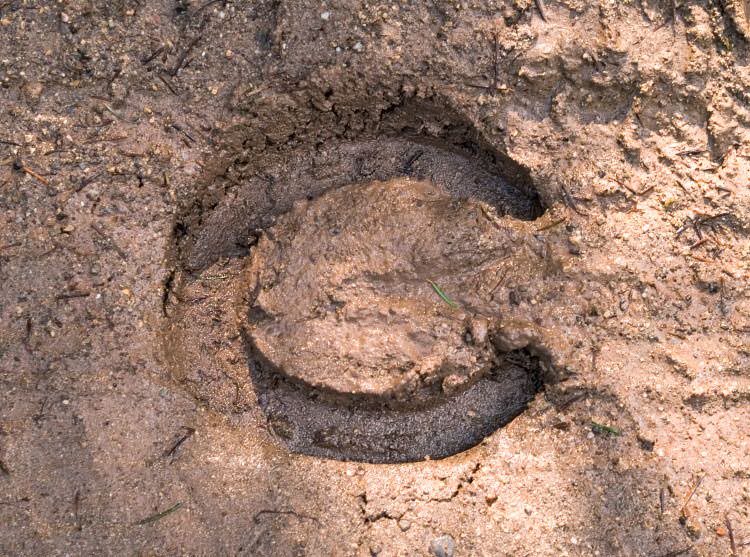Sarah P. fellow mountain biker with her muddy bike (2012).
In order to answer this, we have to start with some basics. Soil particle size! Soil particles are split into various size classes. Basically the diameter of the particle determines what size class it falls into. The two groups are coarse fragments (the big stuff - gravel cobbles,and boulders) and fine earth fraction (sand, silt, and clay). Particles that are 2 mm and smaller fall into the fine earth fraction (per USDA classification). Sand is the largest ranging from 2-0.05 mm with various subdivisions within this, ranging from very coarse to very fine. Silt ranges from 0.05-0.002 mm and clay is 0.002 mm and smaller. The range from boulders to clay is separated by 6 orders of magnitude. This means a clay particle is 1 millionth the size of a boulder! So how do these sizes compare in a more visual sense?

http://school.discoveryeducation.com/schooladventures/soil/name_soil.html
We can see that at the current scale, clay doesn't even show up it is so tiny! So how do these particles influence soil's reaction to water and the pressure we put on it? The combination of these particles (percentages) determine the soil texture. Some of the soil textures you may have heard of are sand, clay, and loam. There are 12 textural classes in total. For example, if soil to has a "clay" texture, it has at least 40% clay sized particles within it. These textures can have an added "modifier" if a certain percent of the sample by volume contains particles in the gravel, cobble, or boulder categories. You could have a soil that is a "gravelly loam" (pictured below). For this blog post I won't go into specifics about how these coarse fraction particles can affect soil, but know their presence can change soils in various areas.
http://www.isric.org/soil_gallery/andosol
Ok, we have learned about particles and how particle combinations result in different textures. How does this play a role in soil compaction after it has rained? Picture your self the size of a sand particle and you are hanging out between the particles. This area between the particles is known as pore space. Most of the spaces between the particles right after a good rain will be filled with water (you can have scuba gear for this imagery if being immersed in water terrifies you!). Now there is pressure exerted from the soil surface, which pushes the soil particles together and fills in the pores (gaps) in between the particles.
Strawberry fields with reduced infiltration.
Why is compaction bad? Compacted soils have higher bulk densities. Bulk density is the mass per volume a soil takes up. Soils with higher bulk densities have reduced infiltration rates. When irrigating, if the rate at which water enters the soil is reduced you can have more runoff and evaporation (lost water). Another problem is reduced air permeability. Reduction in air affects the plant roots and microbes, which can reduce nutrient cycling and over all plant growth. The increase in bulk density means that the soil has to change shape or "structure" is altered and/or reduced. Briefly, structure of the soil is determined by the particles that make up the soil. Generally speaking, soils with more clay (material that can bind particles), will have more structure than those with more sand. Think of the beach. The soil is just one big "massive" accumulation of sand sized material. Where as in your garden you will see small round/crumbles or blocky shapes resulting from clay as well as other constituents in the soil. The presence of water in the soil allows the particles to move more easily over and around each other. This results in loss of soil shape and settling of particles into the pore spaces.

http://kyagextension3.blogspot.com/2013/04/tips-to-prevent-and-improve-soil.html
In areas where farming, construction, or logging occur pausing the work so that plant growth is not impacted makes sense. However, what about trails? There isn't vegetation on the path when you are hiking, mountain biking, or trail riding, so why should we care? As mentioned when soils become compacted soil structure is lost. When soil loses its shape the particles no longer stick together and can become subject to erosion via wind and water (Remember that reduced infiltration concept? Water not entering a soil will travel elsewhere, such as running over a slope. When this happens, it can carry soil particles with it). With soil loss you begin to expose roots. For mountain bikers this adds obstacles, which is fun. However, it can affect the plant life present. The larger roots may be more resistant, but the fine roots holding the soil together can become impacted resulting in further soil loss. Soil loss essentially leads to trail loss and no more fun for you and me.

http://www.americantrails.org/resources/ManageMaintain/Trail-Monitoring-Wimpey-Marion.html
Compacting soil reduces overall soil quality and plant growth and can result in erosion and and soil loss. Although we would love to be able to get out and hike, ride, even get work done on occasion, it is necessary after a precipitation event to allow for the soil to dry out somewhat before we jump back in the saddle.

http://www.structuralrepairoklahomacity.com/foundation-repair/foundation-problems/sinking-outdoor-concrete.html


Inspiration for this article was brought about by some rain today as well as this great article - http://www.hilltromper.com/article/responsible-mountain-biking-rain
ReplyDelete